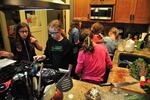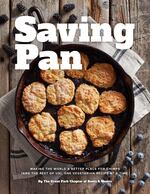
The "Saving Pan" cover features a blackberry-blueberry cobbler made in a cast-iron skillet, one of three meanings of "pan" in the book title. The others references are the genus name for two chimpanzee species and a character in a popular children's story about lost childhood.
Wendi Nordeck, copyright Nordeck Photography Inc.
"I was really in love with primates," said Brooke Abbruzzese of her fifth-grade self. But she was appalled to learn how baby chimpanzees in the African wild are orphaned and abandoned when hunters kill their mothers for meat. Others are stolen and sold illegally as pets or to the entertainment trade.
So in sixth grade, Brooke and 13 classmates at Beverly Cleary School in Portland, Oregon, got together and brainstormed: How could they raise money for the Jane Goodall Institute (JGI) Tchimpounga Chimpanzee Rehabilitation Center in the Republic of Congo, where rescued chimps get a second chance at life?
Forming a chapter of the renowned primatologist's Roots & Shoots global youth-action program, they decided to create, publish and sell a fundraiser vegetarian cookbook, drawing from Portland's vibrant culinary culture. For three-plus years, the girls — helped by their adult "village" — solicited recipes, kitchen-tested dishes, wrote copy, created art work and assisted at photo shoots.
Goodall donated a Vegetarian Angel Hair Pasta recipe and wrote the foreword for "Saving Pan." And in October 2015, as seventh-graders, the girls met her during a big Roots & Shoots project presentation at David Douglas High School in Portland.
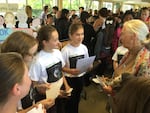
Brooke Abbruzzese (reading from page) and Talia Baskin (red ponytail band) present the girls’ “Saving Pan” cookbook project to Dr. Jane Goodall during a Roots & Shoots event at David Douglas High School in Portland, Oregon, on Oct. 15, 2015. In early 2018, they donated $10,000 from its sales to benefit Goodall’s chimpanzee rehabilitation center and sanctuary in the Republic of Congo.
Courtesy of Chris Abbruzzese
"It was amazing to see her right in front of us," said Emma Francioch, who is turning 15. "Jane Goodall liked the project; she thought it was cool." Emma's family recipe for Skillet Blackberry-Blueberry Cobbler is featured on the softbound book's cover. Her mother, cookbook author Danielle Centoni, served as editor and adviser.
Finally in early December 2017 — the girls are high school freshmen — the self-published "Saving Pan" went on sale online; it's also available at A Children's Place Bookstore in Northeast Portland. About 750 copies sold pretty quickly and the lively, colorful book is in its third printing.
So in a "didn't-quite-see-it-coming" turn, The Grant Park Chapter of Roots & Shoots recently donated $10,000 in proceeds to help care for the 150 chimpanzees at Tchimpounga, Africa's largest such sanctuary. Originally Brooke had wondered how she could raise even $25, but "it definitely got a lot bigger than I expected."
A Magical Alignment
The donation was enthusiastically received at JGI, whose U.S. headquarters is outside Washington, D.C. "This project is magical," said Shawn Sweeney of the community engagement team. "A plant-based cookbook aligns with what Jane Goodall is talking about all the time to her audience. It's not only helping the planet but will ease the suffering of animals and reduce animal-products consumption." Most monetary donations do not address the "incredible amount spent each year to feed the chimps," he noted.

Infant George, victim of the illegal pet trade, arrived at Tchimpounga in November 2017. With around-the-clock care, he is overcoming his early traumas. A produce-rich diet for 24 chimps costs $100 a day, and targeted donations – like the Portland girls' $10,000 – are unusual.
Fernando Turmo / The Jane Goodall Institute
The Tchimpounga chimpanzees "are generally fed fruits (especially papaya and bananas), vegetables, rice, sweet potatoes and locally made soy paste that is high in protein," according to Thalia Kornhauser at JGI Canada in Toronto. "Each month our staff purchases approximately 25,000 kilograms of locally grown fruits and vegetables to feed our chimpanzees." That fresh fruit costs about $50 for 82 kilograms.
In recent years, the sanctuary has expanded to include near-wild forest habitats on three islands protected by a natural river barrier. Through a phased, carefully orchestrated sorting process, two-thirds of the chimps have been transferred from the main site into complex social groups on the islands, where they can roam and forage — to a degree.
"Because many of these chimps don't have the understanding of how to survive on their own, they're still being fed and supplemented by the Tchimpounga staff every day," said community engagement specialist Ashley Sullivan. "So it's kind of an incredible undertaking that this cookbook and these young people are enabling to happen by providing the sustenance that keeps these chimps alive and thriving."
How To Make A Cookbook
To start, the girls wrote chefs as far away as Paris and Seville, Spain. They received recipes from the likes of Michael Pollan, Mollie Katzen, Mark Bittman, Ina Garten, Thomas Keller, Annie Somerville and Alain Passard — but also then-first lady Michelle Obama, who contributed the White House Kitchen Garden Cucumber Soup.
Then they dug in locally, even walking along restaurant-studded Northeast Alberta Street, stopping in to chat with chefs and staffs. Local contributors include Jaco Smith of Lechon (Quinoa and Chickpea Burgers); Jenn Louis of Ray (Lacinato Kale Salad); Back to Eden Bakery (Lemon-Raspberry Poppyseed Bread); Sarah Pliner of Aviary (Chilled Tofu with Scallions, Cantaloupe & Hot Bean Paste); Alex Yoder of Olympia Provisions (Apple & Fennel Salad); and Papa Haydn (French Apple Cake).
To test and work out any kinks in just over 50 recipes, the girls met weekly. "We hosted every Friday night at the start," said Shaanti Abbruzzese, Brooke's mom. "A dozen families hosted at least once during two years." When it got too crowded in the kitchen, some girls moved off and created ripped-paper collages of contributing chefs' faces for the book, working from photos.
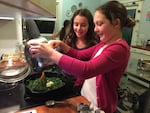
Willa Gagnon, left, and Maeve Larco prepare Mark Bittman's Skillet Spanakopita in January 2015.
Courtesy of Chris Abbruzzese
Early on, "some girls had some skills. Some were leaders," Abbruzzese said. "As it evolved, they learned from each other." She and her husband Chris "are good cooks but remained as hands-off as possible. Toward the end, they were in charge of the whole shebang, including cleanup."
The girls also made dishes at home, took them to Wendi Nordeck's studio and helped style photographs, selecting colors and choosing props.
Tucked into the book are family favorites like Talia Baskin's Mix & Match Pesto Pasta, Charlotte Stoeger's Potato Quinoa Soup, Ruby Cooper-Karl's Swedish Pancakes, Maeve Larco's Aunt Debbie's Artichoke Lasagna and Willa Gagnon's Carrot Cake with Cream Cheese Frosting.
The project website includes the story of how "Saving Pan" came about, photos Chris Abbruzzese has taken to document its progress, and a blog.
Local Action, Global Impact
The girls' cookbook "could not be a better example of how to have an impact on something you're passionate about while focusing on the resources at your disposal" said Adrienne Bermingham, JGI's national program manager for Roots & Shoots. She facilitated Goodall's participation in "Saving Pan."
"It's a big, long-term project with many small projects within it," Bermingham said, and that makes it inspirational. She said young people can jump into Roots & Shoots through small, local one-click campaigns or Facebook activities, whatever their interest — recycling, peace and conflict, climate change, refugees, biodiversity. In the last year, 500 active grassroots projects were submitted in the United States.
JGI recently sent the girls a "very sweet note thanking and congratulating us on the cookbook," enclosing posters and magnets for all. For Brooke, 14, one of the outcomes was very local. Working together for years, the girls got closer: "Our friend group is super-tight."
"I feel like, along with doing something great for the environment and finding our way of giving back, it also developed such a strong community between our families. Especially because there were some families who had just moved to Portland and were still trying to find their community."
Some of the 14 girls have become at least part-time vegetarians. "I thought if I was super passionate about vegetarian cooking, it would be ironic if I would go home and eat chicken," said Brooke. She's stuck with it.
The Jane Goodall Factor
Goodall first gained fame in the 1960s with her groundbreaking work in what is now Gombe National Park in Tanzania. She discovered chimpanzees' ability to make and use tools and documented their surprising, complex social relationships. Her institute, founded in 1977, has expanded its mission and become known for advocacy of global community-centered conservation.
She has a string of titles befitting her reputation and influence: Dr. Jane Goodall, Ph.D., DBE (Dame Commander of the Order of the British Empire), primatologist, ethologist, anthropologist and UN Messenger of Peace.
"Jane is traveling 300 days a year," said Ashley Sullivan. "Her work now is to tour around the world, speaking in as many places as possible to encourage people to think about how what they do matters ... and that they have a role to play in how to protect species and ecosystems." The foremost expert on chimpanzees was in Los Angeles in early April for a fundraiser during a North America tour and will return to the United States in the fall.
The 84-year-old visits her childhood home in Bournemouth, England, "before and after sprints of travel," Sullivan said, and "returns to Gombe once a year to rejuvenate. To feel connected to the forest and chimpanzees and the earth."
On Earth Day (April 22), visitors to Google's search page could click and view a Doodle in which Goodall delivers a thoughtful, inspirational message. "She's truly all over the place," Sullivan said, "to promote the work of the Jane Goodall Institute and just spread hope. That's her main goal."
Quelites With Egg, Salsa Verde & Corn Tortillas | Kelly Myers, Xico
Kelly Myers is executive chef at Xico, a Mexican restaurant in Portland, Oregon. (UPDATE: On April 22, Myers suffered a severe stroke due to complications during surgery to repair an aneurysm, according to Xico owner Elizabeth Davis. She said Myers, 51, is expected to continue recuperating in the hospital and then at home with her family. The Southeast Division Street restaurant remains open.)
Xico takes a very hands-on approach to cooking. They even grind organic corn to make their own tortillas. It’s Mexican food that has been elevated to make it even more interesting and flavorful.
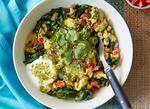
Quelites with Egg, Salsa Verde & Corn Tortillas, from Kelly Myers of Xico restaurant in Portland, is one of 52 vegetarian recipes in the "Saving Pan" cookbook. About half the recipes are from local chefs.
Wendi Nordeck, copyright Nordeck Photography Inc.
“Eggs, spinach, and salsa — what a perfect and power-packed breakfast! The chiles and salsa give these eggs a bit of a kick. If you like a little heat, you won’t be disappointed. In Mexico 'quelites' refers to amaranth greens, but it’s come to be used as a term for just about any mix of tender sautéed greens." — Kelly Myers
Myers said this dish is an old favorite at Xico. She suggests using collard greens – “so sweet” – from 47th Avenue Farm in Southeast Portland. Ingredients are available in most grocery stores, she said, or you can check out Kaah Market at the Portland Mercado.
Prep: 20 minutes | Fairly Easy
Serves 4 to 6 as a light breakfast, appetizer or side dish
Ingredients
- 2 tablespoons extra-virgin olive oil
- 1/2 cup finely chopped white onions
- 1 to 2 serrano or jalapeño chiles, finely chopped
- 2 bunches rainbow chard (or other sturdy, leafy greens), including stems, thinly sliced crosswise into 1/8-inch-wide pieces
- 3/4 teaspoon kosher salt
- 2 Roma tomatoes, diced
- 3 eggs, lightly beaten
- 3 tablespoons chopped fresh cilantro
- 6 tablespoons crema Mexicana or crema Oaxaqueña
- 6 tablespoons salsa verde (see recipe below, or use store-bought), at room temperature
- 8 to 12 corn tortillas (enough for 2 per person)
To prepare
- Heat the oil in a wide pot set over medium-high heat. Add 6 tablespoons of the onion and the chiles. Sauté until edges of onion turn golden. Add sliced greens and salt and mix with the onion and chiles. Sauté until greens wilt but are not soggy. Add the tomato and egg and stir to combine. Cook until the egg is set. Stir in remaining 2 tablespoons onion and the cilantro.
- Meanwhile, warm corn tortillas in batches in a skillet over medium heat, turning them once. Remove hot tortillas to a basket or bowl lined with a clean kitchen towel. Fold towel over the tortillas to keep them warm.
- Serve greens in a bowl with crema spooned over the top. Set salsa verde on the table with the basket of tortillas for guests to serve themselves.
Salsa Verde
Ingredients
- 1/2 pound tomatillos, husks removed
- 2 serrano chiles with seeds, chopped
- 2 tablespoons chopped white onion
- 1 clove garlic, chopped
- 1/3 cup roughly chopped fresh cilantro
- 1 teaspoon kosher salt
To prepare
Bring a medium pot of water to a boil over high heat. Salt generously and add the tomatillos. Boil until soft, about 10 minutes. Drain and let cool. Combine tomatillos in a blender with the remaining ingredients and blend to a slightly textured consistency. Thin with water if desired.
Excerpted with permission from "Saving Pan, Making the World a Better Place for Chimps (and the Rest of Us), One Vegetarian Recipe at a Time" by The Grant Park Chapter of Roots & Shoots. Text copyright 2017 by The Grant Park Chapter of Roots & Shoots. Recipe copyright 2017 by Kelly Myers, Xico restaurant, Portland, Oregon. Recipe photo and author portraits copyright by Nordeck Photography Inc. Face collages republished with permission of The Grant Park Chapter of Roots & Shoots.
Editor’s note: Article updated May 3, 2018, at 12:45 p.m. PT with information about chef Kelly Myers’ stroke and her condition.
